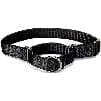I receive many questions related to the various types of collars and head halters. Different collars serve different purposes.  Besides trainers, there are a number of sources where pet parents turn for collar recommendations – for example, pet supply stores, shelters, rescues, or online. Because there are so many choices, types, and brands out in the world, I thought collar information would a wonderful topic for a blog post!Â
A general observation that I hear from clients and other trainers is that if you put ten trainers in a room and ask a “how to†question, you would probably get ten different answers. Well, that may be an exaggeration 😊. With that said, it should be noted that there are three types of trainers – positive trainers, balanced trainers, and compulsion trainers. It is very important that pet parents understand the different types of trainers as it relates to any aspect of dog obedience or behavior modification training, even collars. The different types of trainers may have very different collar recommendations – depending on the type of training. This is a good time to mention that even some shelter and rescue organizations may follow one of the three types of methodologies, therefore, may recommend one type of collar over another to potential adopters.  Â
- Positive trainers use positive reinforcement in their training programs. “Positive training†is a reasonably new training concept as opposed to compulsion training. Positive trainers use rewards such as treats, praise, and toys and do not believe in using any form of punishment in their program. With that said, a positive trainer will not recommend certain types of collars to their clients such as shock or choke collars.
- Balanced trainers use positive reinforcement; however, they may use mild forms of punishment. For example, balanced trainers may recommend the use of a prong collar under certain circumstances.
- Compulsion trainers use positive punishment. Positive punishment techniques typically involve some level of discomfort or pain and may include the use of shock collars, choke collars, and prong collars.
I am going address some of the basic pros and cons related to some of the most popular types of collars and head halters. I will not be covering shock collars, bark collars, or harnesses.  There would be far too much information to process! Also, I will not be recommending the use of certain collars over other collars in this post. You will see that some of the various collar choices may address the same issue – such as pulling on a leash. In this post, I only want to provide some simple, useful and maybe new information to pet parents. Education is so important!Â
I have used a variety of sources, including, of course, my personal experiences. One of my sources for this discussion came from teaching literature developed by the Animal Behavior College (ABC) https://www.animalbehaviorcollege.com/ .Â
Buckle Collar

A buckle collar is one of the most popular collars on the market. When visiting your favorite pet supply store, it is likely that most of the available collars for sale will be buckle collars. A buckle collar has a metal buckle or a plastic clip to secure it around a dog’s neck. It has no moving parts.
PROS
Identification tags can be attached easily.
It is commonly a good first choice for basic obedience training.
It comes in a variety of sizes and is adjustable. Being adjustable can be very cost effective if you have a growing puppy.
CONS
If a pet parent puts pressure on the collar (such as holding the leash tight when walking), the dog’s opposition reflex may engage and may cause the dog to “pullâ€.
If a dog is allowed to put continuous pressure on the collar (for example – pulling on the leash), permanent damage to the dog’s neck and trachea may occur.
It is common and reasonably easy for dogs to slip out of this type of collar on walks, even if fitted properly. This can be especially true for dogs that are reactive and excited.
Martingale Collar

The martingale collar is made with two loops. The larger loop slips onto the dog’s neck. The leash is then clipped to the small loop via a ring. Many martingale collars look very similar to a buckle collar with a plastic clip; however, some martingale collars may use a chain on the smaller loop. When the dog tries to pull, the leash pulls the small loop taut.  This will, in turn, make the large loop tighter around the dog’s neck. This collar is commonly used in place of the choke collar.Â
PROS
Typically, it is easy to fit and is comfortable for most dogs.
In an effort to avoid the risk of unintentional choking or strangulation, it is designed to have limited closure around a dog’s neck.
It is more difficult for dogs to slip out of this collar on walks. This may be a good option for dogs that pull out of buckle collars when reactive or excited.
CONS
It does not prevent pulling. It may even make pulling worse.
This collar is not meant to be left on an unattended or unsupervised dog because there is risk of strangulation. It is possible for the small loop to become caught or hung on an object. The harder a dog pulls, the tighter the collar will become.
Head Halter

Head halters fit over the dog’s nose and neck. They should not be confused with a muzzle. Horse trainers know that by controlling the movement of a horse’s head, it is much easier to control the direction of its body. Head halters for dogs use same principle. There are a number of different brands and types available.
PROS
It can be a good choice for dogs that “pull†on a leash. If introduced, fitted, and used properly, handlers that have become frustrated on walks due to pulling may be able to see positive results fairly quickly.
It can be a good choice when there is a mismatch in physical strength between the pet parent and the dog. For example, if there is a physical mismatch, when a strong dog pulls on a leash, it is possible for the pet parent to be dragged down the street or worse, to the ground. A head halter may give the handler a high level of control without using a great deal of physical strength.
If fitted and used properly, the dog may “self correct†without the need for a handler correction. In other words, when the dog pulls, the head halter will impact the dog’s head and forward motion. Many times, the dog will correct itself and then move forward without pulling.
It is considered by many professionals to be the safest and most humane of any collar.
CONS
It may require significant time and effort to introduce the head halter to the dog. Many dogs are not receptive to the nose loop. For the dog to feel comfortable wearing the head halter, the pet parent may be required to go through positive reinforcement process. If a pet parent puts uses the head halter on a walk without proper introduction, the dog may paw at it or refuse to move.
If not introduced properly and/or fitted properly, the dog may be able to get out of the head halter.
It may be difficult to fit brachycephalic (“shortened headâ€) breeds (for example, Pugs, Bull Mastiffs, English or French Bulldogs, Boxers, etc.) or dogs with protruding eyes.
It can cause neck injury if used improperly.
It may only be a temporary solution for leash pulling. Dogs may resume pulling if switched to a different type of collar such as a buckle collar.
Prong/Pinch Collar

Prong or Pinch collars have interlocking metal links. These links have blunt ends that are designed to pinch the dog’s skin when the collar tightens – for example, the collar will tighten when a dog is pulling or lunging. A proper fit is critical.
PROS
It may be an option for a very strong dog or a dog that pulls on a leash.
It is designed to only constrict enough to allow a pinch versus allowing constriction of a dog’s airway.
It is designed to allow the dog to “self correct†without the need for human correction.
It can produce instantaneous results with a slight correction.
CONS
It can look scary to humans.
It should not be left on unsupervised or unattended dogs.
It can be difficult to fit and proper fit is critical.
It can easily inflict pain instead of a “pinch†if not fitted or used properly.
If the collar causes pain or if the handler’s corrections are poorly timed, the dog may develop negative associations to people or other dogs and react accordingly. Even aggression may develop. For example, let’s say your neighbor is a middle aged man that has a red hair. He walks his black Lab at the same time you do most days. Your dog gets excited when it sees your neighbor. In an effort to control your dog’s excitement, you pull the prong collar tight. Instead of just a pinch, the collar causes pain. Suddenly, your dog reacts or shows signs of aggression toward men with red hair as well as large black dogs when it is out in public. Your dog now associates red hair or black dogs with discomfort/pain.Â
It can come apart and should be checked often.
Choke/Slip Collar

Chokes collars have large rings on each end. The collar itself can be made out of a variety of materials, including chain. When the collar material is pulled through one of the rings, it makes a circle. When the circle is formed, one of the rings can then move. As the leash tightens, the collar tightens around the dog’s neck. A proper fit is critical.
PROS
Corrections produce fairly immediate results.
CONS
It can easily be used incorrectly or inappropriately.
It may cause injury to a dog’s trachea, cervical vertebrae, or spine if used incorrectly – for example if corrections are strong or if there is routine or continuous pressure from the collar around the dog’s neck.
Poorly timed handler corrections may cause the dog to develop negative associations with people or other dogs. As with other collars such as the prong/pinch collar, negative associations may also lead to aggression.
There is no safety device to prevent strangulation. This collar should not be left on an unattended or unsupervised dog.
The End
Hopefully this post has provided useful information! If you have any questions, please contact me! I would love to assist you further.Â